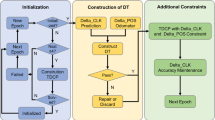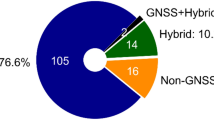Abstract
A GPS positioning algorithm is studied and applied to locate a spinning vehicle on which a single-patch antenna is mounted. Because the antenna is directional and the received signal is periodically discontinuous, the bits and frames cannot be synchronized to assemble the transmission time of the satellite signals. The characteristics of the signals received by a single-patch antenna are described. The means by which the tracking loop works with these discontinuous signals are analyzed and simulated. Aiming at spinning projectiles, the positioning algorithm forming differencing with respect to a reference satellite is applied to locate the spinning vehicle by using code phases obtained in the tracking of the discontinuous signals. Experiments were carried out, and the results showed that the positioning algorithm works properly on the spinning vehicle. The results revealed that the positioning error of the algorithm applied to a spinning vehicle is close to that of the conventional positioning method applied to a non-spinning vehicle.













Similar content being viewed by others
References
Akopian D, Syrjärinne J (2009) A fast positioning method without navigation data decoding for assisted GPS receivers. IEEE Trans Veh Technol 58(8):4640–4645
Alexander SB, Redhead R (2012) Systems and methods for determining a rotational position of an object. US Patent 8,199,052.2012-6-12
Chen HW, Wang HS, Chiang YT, Chiang FR (2014) A new coarse-time GPS positioning algorithm using combined Doppler and code-phase measurements. GPS Solut 18(4):541–551
Doty JH (2001) Advanced spinning-vehicle navigation-A new technique in navigation of munitions. In: ION 57th Annual Meeting, pp 745–754
Higgins WJ, Bader JR, Nelson ED, Corcoran MA (2001) Fast acquisition of GPS signal corrupted by Doppler or time delay effects. US Patent 6,259,400. 2001-7-10
Kaplan ED, Hegarty C (2006) Understanding GPS: principles and applications. Artech House, Boston
Kim JW, Shin MY, Melin L, Hwang D-H, Lee SJ (2008) GNSS receiver rotation tracking loop design for spinning vehicles. In: Position, Location and Navigation Symposium, ION IEEE, pp 181–186
Lindquist E, Kreichauf RD (2008) Apparatus and appertaining method for upfinding in spinning projectiles using a phase-lock-loop or correlator mechanism. US Patent 7,395,987. 2008-7-8
Luo J, Vander Velde WE, Tseng HW, Upadhyay TN (2012) Single antenna GPS measurement of roll rate and roll angle of spinning platform. US Patent Application 13/374,551. 2012-1-3
Mickelson WA (2000) Navigation system for spinning projectiles. US Patent 6,163,021. 2000-12-19
Underwood D (1999) Space rockets, polar bears, and Tundra Buggies–and a GPS link to the seventeenth century. GPS Solut 3(2):48–52
Van Diggelen F (2002) Method and apparatus for time-free processing of GPS signals. US Patent 6,417,801.2002-7-9
Van Diggelen F (2009) A-GPS: assisted GPS, GNSS, and SBAS. Artech House, Boston
Author information
Authors and Affiliations
Corresponding author
Rights and permissions
About this article
Cite this article
Shen, Q., Li, M. & Gong, R. GPS positioning algorithm for a spinning vehicle with discontinuous signals received by a single-patch antenna. GPS Solut 21, 1491–1502 (2017). https://doi.org/10.1007/s10291-017-0623-8
Received:
Accepted:
Published:
Issue Date:
DOI: https://doi.org/10.1007/s10291-017-0623-8




